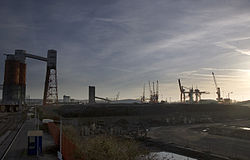Avonmouth Docks
| Avonmouth Docks | |
|---|---|

The docks, as seen from St Andrews Road. The coal loading silos can be seen on the left, with the Avonmouth container terminal on the right
|
|
| Location | |
| Country | United Kingdom |
| Location | Mouth of the River Avon, Bristol, England |
| Coordinates | 51°30′18″N 2°42′25″W / 51.505°N 2.707°WCoordinates: 51°30′18″N 2°42′25″W / 51.505°N 2.707°W |
| Details | |
| Opened | 1877 |
| Operated by | The Bristol Port Company (150 year lease from 1991) |
| Owned by | Bristol City Council |
| Type of harbor | Artificial |
|
Website http://www.bristolport.co.uk/ |
|
The Avonmouth Docks are part of the Port of Bristol, in England. They are situated on the northern side of the mouth of the River Avon, opposite the Royal Portbury Dock on the southern side, where the river joins the Severn estuary, within Avonmouth.
Accessible via a 210 metres (690 ft) long and 30 metres (98 ft) wide lock, today the docks are one of the UK's major ports for chilled foods, especially fruit and vegetables. Land-side freight access and distribution is via either the M5 motorway or the Henbury Loop Line, whilst rail-passenger access is via Avonmouth railway station on the Severn Beach Line.
Bristol Harbour had always been a major centre of trade within the wider UK economy, due to its strategic location to the west of the country, allowing access to both the Atlantic Ocean and the Mediterranean. Coastal trade was also important, with the area called "Welsh Back" concentrating on trows with cargoes from the Slate industry in Wales, stone, timber and coal.
However, by the 18th century the docks in Liverpool grew larger and so increased competition with Bristol for the tobacco trade. The limitations of Bristol's docks were causing problems to business, so in 1802 William Jessop proposed installing a dam and lock at Hotwells to create the floating harbour. Construction of the £530,000 scheme began in May 1804, including the construction of the Cumberland Basin, the tidal new cut and a feeder canal to Temple Meads. Entrance was via locks, which had a maximum width of 45 ft (13.7 m). The harbour was officially opened on 1 May 1809.
...
Wikipedia
